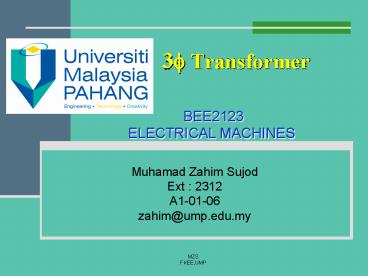3 Transformer PowerPoint PPT Presentation
1 / 29
Title: 3 Transformer
1
3? Transformer
BEE2123 ELECTRICAL MACHINES
- Muhamad Zahim Sujod
- Ext 2312
- A1-01-06
- zahim_at_ump.edu.my
2
Learning Outcomes
- At the end of the lecture, student should be able
to - Understand the principle and the nature of 3
phase transformer. - Perform an analysis on 3 phase transformers which
their principles are basic to the understanding
of electrical machines.
3
Introduction
- A 3? transformer is essentially 3 single phase
transformer wound on a common core. - The geometry of the core is such that the fluxes
of the phases share common paths as a result,
the volume of iron in 3? transformer is less than
the volume of iron of 3 single phase transformer
of the same rating. Hence, the cost is reduced. - ? any phase of a 3? transformer behaves exactly
like a single phase transformer. - In 3? transformer, the primary and secondary
windings can be connected either in Y or ?. - The possible connection are
- Primary Secondary
- ? ?
- ?
Y - Y
? - Y
Y
4
Transformer Construction
- 3 Single Phase Transformer
- Used a lot in older transformer
- adv- each unit in the bank can be replaced
- individually
5
Transformer Construction
- 3? Transformer wound a single three legged iron
core
- more preferred in practice
- adv- lighter, smaller, cheaper, slightly more
- efficient
- iron core must be laminated
- to reduce eddy current loss
- iron must be made of soft iron
- to reduce hysteresis loss
- cooling the transformer - use fan or heat sink
- soft iron must be add with 3-5 silicon - to
increase the saturation flux in the
iron - The amount of silicon must not too high
otherwise the iron will be brittle - clamp the lamination - to reduce the humming
noise
6
Delta (?) Delta (?) Connection
- This connection is economical for large,
low-voltage transformers in which insulation
problem is not so urgent.
7
Delta (?) Delta (?) Connection (Schematic
Diagram)
8
Delta (?) Delta (?) Connection (Schematic
Diagram)
Refer to primary,
9
Star (Y) Star (Y) Connection
- This connection is the most economical for small,
high voltage transformers.
10
Star (Y) Star (Y) Connection (Schematic Diagram)
11
Star (Y) Star (Y) Connection (Schematic Diagram)
Refer to primary,
12
3rd harmonic phenomenon and unbalanced loading
- The Y-Y connection has two very serious problems
- If loads on the transformer circuit are
unbalanced, then the voltages on the phases of
the transformer can become severely unbalanced - There is a serious problem with third harmonic
voltages - Solution to the problem
- Solidly ground the neutrals of the transformer
- Introduced a third winding connected in ?
13
Star (Y) Delta (?)
- This type of connection is mainly used for the
system where we need to step-down the voltage.
14
Star (Y) Delta (?) Connection (Schematic
Diagram)
15
Star (Y) Delta (?) Connection (Schematic
Diagram)
Refer to primary,
16
Delta (?) Star (Y)
- This type of connection is mainly used for the
system where we need to step-up the voltage.
17
Delta (?) Star (Y) (Schematic Diagram)
18
Delta (?) Star (Y) (Schematic Diagram)
Refer to primary,
X01
R01
19
Auto-Transformer
- Auto-Transformer is a transformer with only one
winding. - That means, the primary and secondary windings
are not electrically isolated form each other. In
other words, the primary and the secondary of
autotransformer are physically connected. - The theory is almost the same as two winding
transformer.
20
Auto-Transformer (Equivalent Circuits)
Step-up Autotransformer
Step-down Autotransformer
Multiple Tap Autotransformer
Multiple Tap Autotransformer with load
21
Auto-Transformer (Analysis for Step-up Autotrans)
V1
N1
V1
N1
Two winding Transformer
Connection as an Auto-Transformer
22
Auto-Transformer (Analysis for Step-up Autotrans)
1. Voltage Rating
2. Current Rating
3. Autotrans Turns-Ratio
23
Auto-Transformer (Analysis for Step-up Autotrans)
4. kVA Rating
5. Efficiency
24
Auto-Transformer (Example)
- A single phase, 100kVA, 2000/200V two-winding
transformer is connected as an autotransformer as
shown in Figure 1 such that 2000V is obtained at
secondary. The portion ab is the 200V winding,
and the portion bc is the 2000V winding. Compute
the kVA rating as an autotransformer. Also
calculate the efficiency for a given losses of
2800W at 0.866 lagging power factor.
Figure 1
25
Auto-Transformer (Example)
26
Advantages and Drawback of Auto-Transformer
- Advantages
- The secondary winding is as part of primary
winding. Hence, autotransformer eliminates the
need for a separate secondary winding. - As a results, autotransformers are always
smaller, lighter, and cheaper.
- Drawback
- Absence of electrically isolation is a serious
drawbacks in some applications
27
Instrument Transformer
- Voltage Transformer (Potential Transformer)
- Is used to measure or monitor the voltage on
transmission lines and to isolate the metering
equipment from the lines.
28
Instrument Transformer
- Current Transformer
- Is used to measure or monitor the current in
transmission lines and to isolate the metering
equipment and relay connected to secondary side.
29
Other Types of Transformer
- High Frequency Transformer
- In electronic power supplies, there is always a
need to isolate the output from the input and to
reduce the weight and cost of unit. - The objective are best achieved by using a
relatively high frequency compared to normal
frequency of 50Hz / 60Hz.

